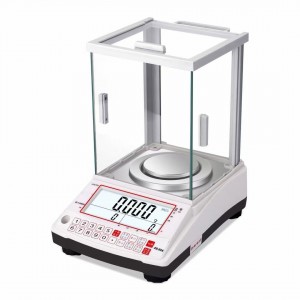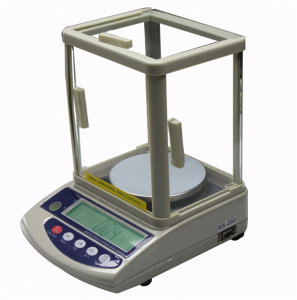ဝန်ခံနိုင်စွမ်းမရှိပါ- ချိန်ခွင်လျှာကိုလျှော့ချရန် လက်ကိုင်ခလုတ်ကို ညင်သာစွာ ဝက်အူဖြုတ်ပါ၊ ချိန်ခွင်လျှာ၏ သုညအမှတ်ကို မှတ်တမ်းတင်ပါ၊ ထို့နောက် ဟန်ချက်အလင်းတန်းကို လွှင့်တင်ရန် ခလုတ်ကိုပိတ်ပါ။ 10mg coil ကုဒ်ကိုယူရန် ချိန်ခွင်လျှာ၏ဘယ်ဘက်အခြမ်းအလယ်တွင် ခြစ်တံကိုအသုံးပြုပါ။ လက်ကျန်အမှတ်နှင့် သုညမှတ်ကြား ကွာခြားချက်မှ ချိန်ခွင်လျှာအချက်ကိုဖတ်ပါ၊ ခလုတ်ကိုပိတ်ပြီး ဗလာဒစ်အာရုံခံနိုင်စွမ်း (အသေးစားဂရစ်/mg) နှင့် ချိန်ခွင်လျှာအမှတ်နှင့် သုညမှတ်ကြား ကွာခြားချက်မှ အာရုံခံနိုင်စွမ်း (mg/small grid) ပြီးနောက် ခလုတ်ကို ဝက်အူဖြုတ်ပါ။
Ⅰ. အသွင်အပြင် စစ်ဆေးခြင်း-
1. လက်ကျန်အဖုံးကို ဖြုတ်ချပြီး စည်းကာ သင့်လျော်သော အနေအထားတွင် ထားရှိကာ အလေးချိန်ကို စစ်ဆေးပါ။. သေတ္တာထဲက အလေးချိန်တွေ ပြည့်စုံမှုရှိမရှိ၊ ကုပ်အတွက် ကပ်ဖို့ပဲဖြစ်ဖြစ်၊အလေးလက်စွပ်အလေးများသည် နဂိုအတိုင်းဖြစ်ပြီး ကွင်းချိတ်တွင် မှန်ကန်စွာချိတ်ထားခြင်းရှိမရှိ၊ နှင့် စာဖတ်ဒစ်၏ဖတ်ခြင်းအား သုညတွင်ရှိမရှိ ဘောက်စ်ထဲတွင် ရှိနေပါသည်။
2. လက်ကျန်ဒယ်အိုးပေါ်တွင် ဖုန်မှုန့် သို့မဟုတ် အခြားအရာများ ပြုတ်ကျပါက၊ ၎င်းကို နူးညံ့သော စုတ်တံဖြင့် သန့်စင်သင့်သည်။ ခွဲခြမ်းစိတ်ဖြာချိန်ခွင်လျှာသည် အချို့သောပစ္စည်း၏ထုထည်ကို တိကျစွာချိန်တွယ်ရန်အတွက် တူရိယာတစ်ခုဖြစ်သည်။ အလေးချိန်မချိန်မီ၊ ချိန်ခွင်လျှာသည် ပုံမှန်ဟုတ်မဟုတ်၊ အလျားလိုက် အနေအထားတွင်ရှိမရှိ၊ ရုတ်သိမ်းထားသော အိတ်များနှင့် လက်စွပ်အလေးချိန်များ ပြုတ်ကျခြင်းရှိမရှိ၊ မှန်ဘောင်၏ အတွင်းနှင့် အပြင်ပိုင်း သန့်ရှင်းမှုရှိမရှိ စစ်ဆေးပါ။
3. ချိန်ခွင်လျှာသည် ကျန်အခြေအနေတွင်ရှိမရှိ စစ်ဆေးပြီး ချိန်ခွင်လျှာနှင့် ရုတ်သိမ်းခြင်း၏ အနေအထားသည် ပုံမှန်ဟုတ်မဟုတ် စစ်ဆေးပါ။ အီလက်ထရွန်းနစ် ချိန်ခွင်လျှာကို အရာဝတ္ထုများ အလေးချိန်အတွက် အသုံးပြုသည်။ အီလက်ထရွန်းနစ်ချိန်ခွင်လျှာသည် ယေဘူယျအားဖြင့် အာရုံခံအာရုံခံကိရိယာ၊ စွမ်းရည်အာရုံခံကိရိယာနှင့် လျှပ်စစ်သံလိုက်ချိန်ခွင်လျှာချိန်ခွင်လျှာအာရုံခံကိရိယာတို့ကို လက်ခံပါသည်။ အာရုံခံကိရိယာတွင် ရိုးရှင်းသောဖွဲ့စည်းပုံ၊ ကုန်ကျစရိတ်နည်းသော်လည်း တိကျမှုအကန့်အသတ်ရှိသည်။
5. လက်ကျန်ငွေသည် အလျားလိုက်အနေအထားတွင်ရှိမရှိ စစ်ဆေးပါ။ မဟုတ်ပါက၊ အလယ်ဗဟိုရှိ ပူဖောင်းအဆင့်ရှိ ပူဖောင်းများကို ချိန်ခွင်လျှာ၏အရှေ့ဘက်အောက်ရှိ ခြေဖဝါးအောက်ရှိ အလျားလိုက်ချိန်ညှိခြင်းဝက်အူနှစ်ခုကို ချိန်ညှိပါ။
Ⅱ. အာရုံခံနိုင်စွမ်း- ချိန်ခွင်လျှာ၏ အာရုံခံနိုင်စွမ်းသည် 1mg အလေးချိန်တိုးလာခြင်းကြောင့် ဖြစ်ပေါ်လာသော လက်ကျန် သုညအမှတ်နှင့် ရပ်တန့်မှတ်ကြားရှိ ဂရစ်ကွက်အရေအတွက် အနည်းငယ်မျှသာဖြစ်သည်။ ချိန်ခွင်လျှာသည် ပို၍ ထိလွယ်ရှလွယ်လေလေ၊ ဇယားကွက်များကို ထေမိလေဖြစ်သည်။ ညွှန်ပြချက်ကို ဂရစ်တစ်ခုဖြင့် ပြောင်းသောအခါ လိုအပ်သော အရည်အသွေးကို ရည်ညွှန်းသည့် အာရုံခံနိုင်စွမ်းကို အများအားဖြင့် ဖော်ပြသည်။
Ⅲ. သုည ချိန်ညှိခြင်း- လက်ကျန်၏ သုညမှတ်သည် လက်ကျန်ကို ဖြုတ်လိုက်သောအခါ လက်ကျန်အမှတ်ကို ရည်ညွှန်းသည်။ ချိန်ခွင်တစ်ခုစီ၏ သုညအမှတ်ကို တိုင်းတာရပါမည်။ အီလက်ထရွန်းနစ် ချိန်ခွင်လျှာကို အရာဝတ္ထုများ အလေးချိန်အတွက် အသုံးပြုသည်။ အီလက်ထရွန်းနစ်ချိန်ခွင်လျှာသည် ယေဘူယျအားဖြင့် အာရုံခံအာရုံခံကိရိယာ၊ စွမ်းရည်အာရုံခံကိရိယာနှင့် လျှပ်စစ်သံလိုက်ချိန်ခွင်လျှာချိန်ခွင်လျှာအာရုံခံကိရိယာတို့ကို လက်ခံပါသည်။ အာရုံခံကိရိယာတွင် ရိုးရှင်းသောဖွဲ့စည်းပုံ၊ ကုန်ကျစရိတ်နည်းသော်လည်း တိကျမှုအကန့်အသတ်ရှိသည်။ လက်ကျန်ပုံသဏ္ဍာန်ကို စစ်ဆေးခြင်းပြီးသောအခါ၊ ပါဝါထောက်ပံ့မှုကိုဖွင့်ပြီး လက်ကိုင်ခလုတ်ကို အဆုံးအထိ နာရီလက်တံအတိုင်းလှည့်ပါ (လက်ကျန်ကိုဖွင့်ပါ)။ ဤအချိန်တွင်၊ သေးငယ်သောစကေး၏ပုံသဏ္ဍာန်သည် အလင်းစခရင်ပေါ်တွင် ရွေ့လျားနေသည်ကို သင်တွေ့မြင်နိုင်သည်။ စကေးသည် နာရီရှိသက်ဆိုင်ရာအချိန်ကိုညွှန်ပြရန်အသုံးပြုသည့်အစိတ်အပိုင်းများသည်တည်ငြိမ်သည် (တည်ငြိမ်သည်၊ မပြောင်းလဲပါ)၊ အလင်းစကရင်ပေါ်ရှိစကေးမျဉ်းသည် စကေး၏ 0.00 မျဉ်းနှင့်မတိုက်ဆိုင်ပါက၊ lifting knob အောက်ရှိ သုညချိန်ညှိလှံတံကို တစ်ထပ်တည်းဖြစ်စေရန် အလင်းစခရင်ကိုရွှေ့ရန် ခလုတ်ဖွင့်နိုင်ပြီး သုညအမှတ်ကို ချိန်ညှိမည်ဖြစ်သည်။ အလင်းစခရင်သည် အဆုံးသို့ရွေ့သွားပြီး မျဉ်း 0.00 မျဉ်းနှင့် မဆုံနိုင်သေးပါက၊ ကျေးဇူးပြု၍rချိန်ညှိရန် ချိန်ခွင်လျှာရှိ ချိန်ခွင်လျှာကို ချိန်ညှိပါ။
တင်ချိန်- အောက်တိုဘာ ၂၁-၂၀၂၂


